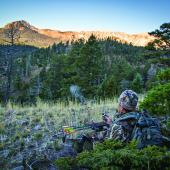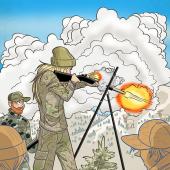Mountain Time
Exploring Montana's high terrain.
Like many east-coast transplants, I began my outdoor career in what we called “mountains” but were really just hills. I didn’t learn about hunting real mountains until my family moved west, and I’ve spent the last 60 years refining that knowledge, often by learning from my own mistakes.
The well-defined terrain in most mountain habitat makes navigation easy even without GPS technology. As you leave camp or the trail, keep track of where you would wind up if you were a drop of water flowing downhill. Unless you cross into a different drainage—and take careful bearings if you do—all you need to do to get back to where you started is walk downhill.
When in doubt, however, return by the route you came. Otherwise, if you walk aimlessly down enough fall lines, you’ll eventually get cliffed-out—stuck above steep terrain you can’t descend. During daylight in good weather, you’ll just have to climb the mountain twice. But cliffing out in the dark during a snowstorm may leave you facing a cold night in the woods, if not serious injury. This phenomenon is particularly common when hunting alpine species such as sheep or goats, but it can also ruin your day while pursuing elk or blue grouse.
Mountain weather is notoriously subject to frequent, unexpected change. Light clothing may be appropriate at the start of an early-season elk hunt, but your daypack should include clothing warm enough to keep you comfortable and safe even if you encounter an early snowstorm.
Montana’s mountains are serious bear country, and those who hunt them need to understand and practice basic bear-avoidance, a topic beyond the scope of this discussion. All hunters—especially those carrying bows rather than firearms—should carry bear spray in a readily available location and know how to use it long before they have to.
While most backcountry travelers worry about grizzlies, never underestimate black bears. During the many years I spent in Alaska, I faced more dangerous situations with black bears than grizzlies. Nevertheless, the presence of these large apex predators should enhance rather than detract from the mountain-hunting experience, and it will if the hunter is adequately prepared.
As dramatic as an aggressive bear encounter can be, falls injure far more mountain hunters than wild animals ever will. Plan your routes carefully and hunt with an experienced companion whenever possible. If you hunt solo, be sure a reliable party knows where you are going and when to expect you back. To prevent an unnecessary search-and-rescue deployment, check in upon return.
Newcomers to western hunting often don’t realize how much effort they’ll have to invest in packing out game after a successful hunt. Those who have had some experience with deer are usually unprepared for their first close-up look at a dead elk (and even experienced elk hunters may be shocked the first time they approach a downed moose). Meat salvage should always be the paramount concern, especially during the warm archery season. Hunter and partners (you’ll never appreciate them more) should be able to get the animal field-dressed and quartered quickly, and leave the quarters hanging before tackling the challenge of getting all that prime venison out of the mountains. That will require knives, sharpening tools, a generous amount of rope or cord, and game bags. Then the real fun begins.
What happens next depends on weather, terrain, the amount of help available in camp, and the size of the animal. In the mountains, cutting up the animal and packing it out in pieces is a better choice than trying to drag it out whole, especially if the animal is an elk. Horses can be invaluable if you have them and know how to pack. If not, previous arrangement with a standby local horse-packer can save the day.
All this sounds like a lot of work, and it is. However, as you enjoy those prime elk steaks over the winter, remembering the effort you invested in harvesting the meat and getting it off the mountain will only enhance its flavor.












